|
The 1870 Regulator
Before . . .
. . . After
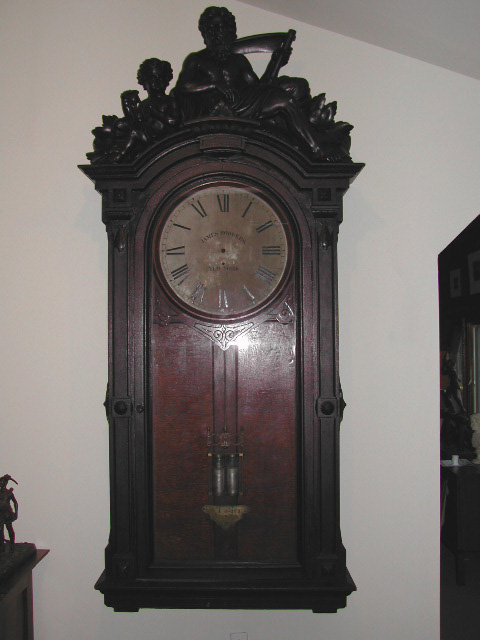
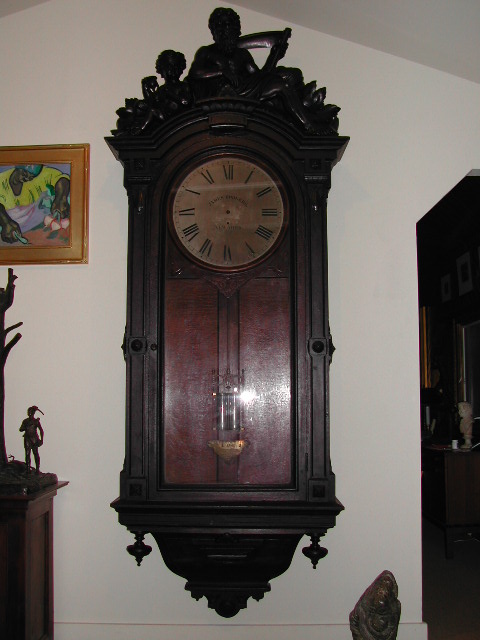
On the left, the Regulator hanging as is, without its original base and finials
and is then shown on the right with its missing base and finials restored,
a magnificent transformation! With the restored base the clock
measures 9 foot 3 inches tall and 3 foot 6 inches inches wide at its
widest point.
Restoration
Begins
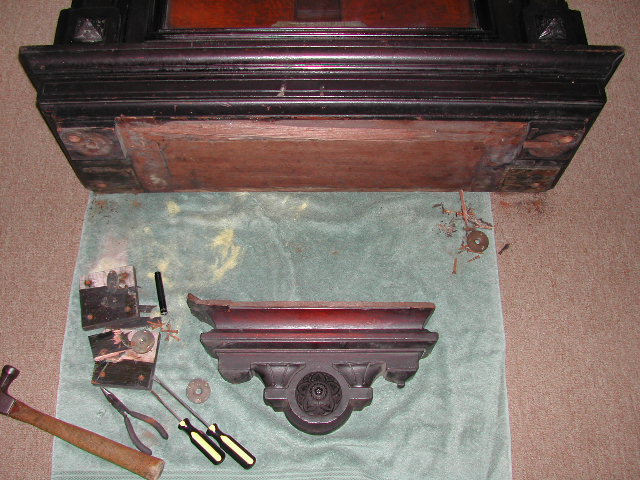 The
first two activities on the 1870 regulator were to (1) replace the missing
base and finials and (2) replace the missing hand and pulley. The
clock had remained upright balanced on metal feet that were mounted on the
original finial supports and two modern, plywood supports that mirrored
the original finial bases. These were removed and it became plainly
apparent that they were indeed later as no oxidation was present from any
earlier mounting. The size of missing "Vienna regulator" type base
was surmised by both the original outline of the base and the remaining
decorative extremity tip. Together they provided enough information
to assume a length of approximately 18 inches from the base of clock to
the tip of the decorative, Vienna base and a width of 26 inches between
the two finial bases. The finials would have to be in proportion to
the new base and oxidation rings indicated a base diameter for each finial
of approximately 3 inches, indicating a proportional length and width of
approximately 6 inches each. The
first two activities on the 1870 regulator were to (1) replace the missing
base and finials and (2) replace the missing hand and pulley. The
clock had remained upright balanced on metal feet that were mounted on the
original finial supports and two modern, plywood supports that mirrored
the original finial bases. These were removed and it became plainly
apparent that they were indeed later as no oxidation was present from any
earlier mounting. The size of missing "Vienna regulator" type base
was surmised by both the original outline of the base and the remaining
decorative extremity tip. Together they provided enough information
to assume a length of approximately 18 inches from the base of clock to
the tip of the decorative, Vienna base and a width of 26 inches between
the two finial bases. The finials would have to be in proportion to
the new base and oxidation rings indicated a base diameter for each finial
of approximately 3 inches, indicating a proportional length and width of
approximately 6 inches each.
Ernest St. George, master wood carver from Romania, was
selected to carve a new base while wood turner Chuck O'Malley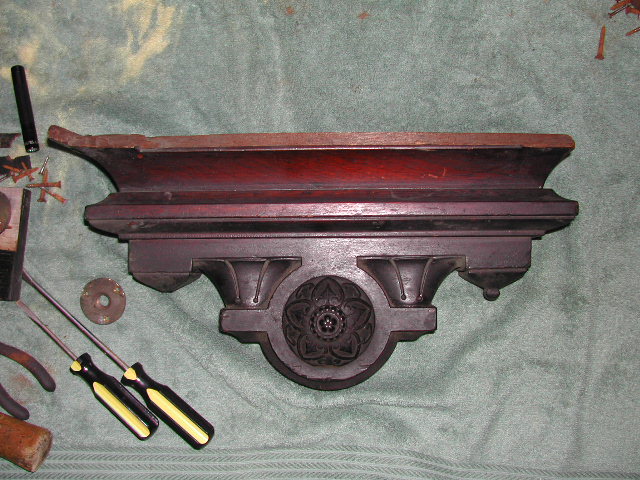 was selected to create the two new finials for the base. All would
be built out of clear Walnut in an attempt to match as closely as possible
the original casework. The shape of the base was decided upon by
creating a scaled drawing of the remaining extremity tip and the base of
the existing clock and aligning the two. This process was further
aided by the small amount of the mid section of the base which was still
present and attached to the extremity tip. this detail provided the
curvature and flair for the final design of the replacement base.
The new base would have a incised line mimicking a recessed panel on all
three side of the new mid section. This detail was found on the
remains of the old mid section and would be matched as closely as possible
in the restoration. An additional decoration was chosen to adorn the
new mid section. A detail from the top of the clock would be copied
in a reduced form and flattened out to match the curvature on the new base
mid section. This decoration would be carved directly out of the new
mid section and would not be applied as this would have been the typical
manner of producing such an effect during the third quarter of the 19th
century. The newly constructed base and finials will be stained and
finished to match the original "dirty" finish of the rest of the clock
case.
was selected to create the two new finials for the base. All would
be built out of clear Walnut in an attempt to match as closely as possible
the original casework. The shape of the base was decided upon by
creating a scaled drawing of the remaining extremity tip and the base of
the existing clock and aligning the two. This process was further
aided by the small amount of the mid section of the base which was still
present and attached to the extremity tip. this detail provided the
curvature and flair for the final design of the replacement base.
The new base would have a incised line mimicking a recessed panel on all
three side of the new mid section. This detail was found on the
remains of the old mid section and would be matched as closely as possible
in the restoration. An additional decoration was chosen to adorn the
new mid section. A detail from the top of the clock would be copied
in a reduced form and flattened out to match the curvature on the new base
mid section. This decoration would be carved directly out of the new
mid section and would not be applied as this would have been the typical
manner of producing such an effect during the third quarter of the 19th
century. The newly constructed base and finials will be stained and
finished to match the original "dirty" finish of the rest of the clock
case.
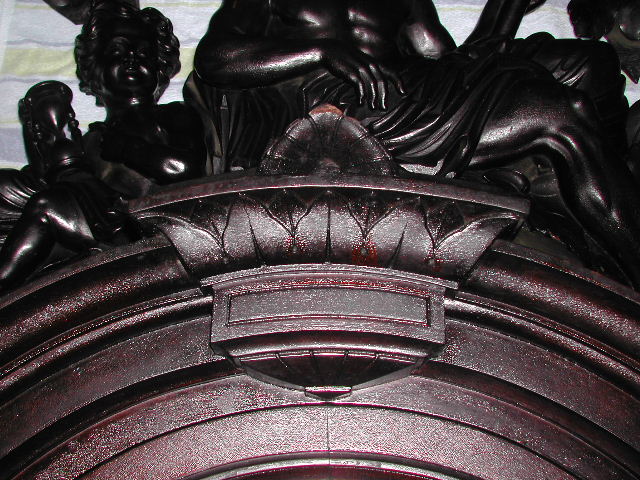
Pictured to your right is a detail shot of the top of the clock case
showing the detail mentioned above. The new base was constructed in
the following manner: A trapezoidal pine frame was created and then
several inches of Walnut stock was glued to it. After curing, the
shape of the base was laid out onto the Walnut and Mr. St. George began
carving away the surface to form the shape of the base. The portion
of the detail copied from the top of the clock was reproduced in the same
fashion, carved right out of the newly formed base piece. Once
completed the faux panel detailing that is present on the rest of the case
and on the remains of the original base was reproduced. The final
portion of the work was to remove the broken portion of the base from the
tip decoration and attach the old to the new. This was done from
behind using wood screws and wood glue. Finally the finished base
was sanded down as were the completed finials. All three pieces were
delivered to a finishing specialist in Brooklyn, NY so the original, old
dirty finish could be matched to the rest of the clock. When the
newly finished base and finials was returned all that remained was the
process of attaching them to the base. Originally, the base and
finials were glued and screwed in position. This would make the
clock nearly impossible to lower from the wall and very difficult to
transport. In this case, it was decided to mount the new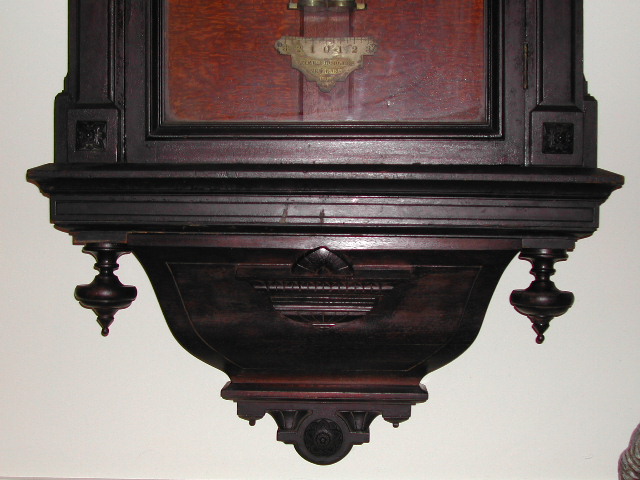 base using four screw-holes by which the original base was attached.
The finials were drilled out to accept a screw and are simply hanging from
a large washer. This process has made possible the easy removal of
the base and finials for transportation purposes. The new base is
nearly impossible to detect from the remainder of the old case, as are the
finials. With the base portions of the clock complete only a few
items remain to work on: The glass, and the making of one hand and
base using four screw-holes by which the original base was attached.
The finials were drilled out to accept a screw and are simply hanging from
a large washer. This process has made possible the easy removal of
the base and finials for transportation purposes. The new base is
nearly impossible to detect from the remainder of the old case, as are the
finials. With the base portions of the clock complete only a few
items remain to work on: The glass, and the making of one hand and
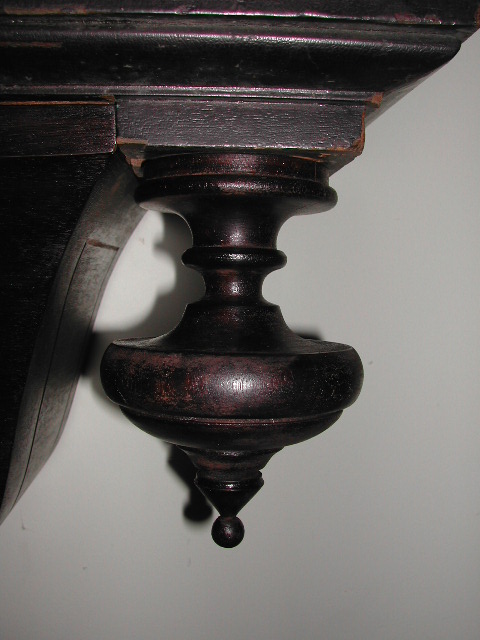 one
pulley based upon the originals. The process of creating the missing
hand and pulley is already underway. Deciding on the kind of
decorated glass that once was likely to have been in the clock is a more
difficult aspect. What should it say, if anything? How should
it look? What design should be chosen? These are all difficult
questions and need to be dealt with before the decoration of the glass can
be completed. Certainly it should not be etched, but gold decorated
which was the most typical form for the period. But how to chose a
design? one
pulley based upon the originals. The process of creating the missing
hand and pulley is already underway. Deciding on the kind of
decorated glass that once was likely to have been in the clock is a more
difficult aspect. What should it say, if anything? How should
it look? What design should be chosen? These are all difficult
questions and need to be dealt with before the decoration of the glass can
be completed. Certainly it should not be etched, but gold decorated
which was the most typical form for the period. But how to chose a
design?
Continued
. . .
|